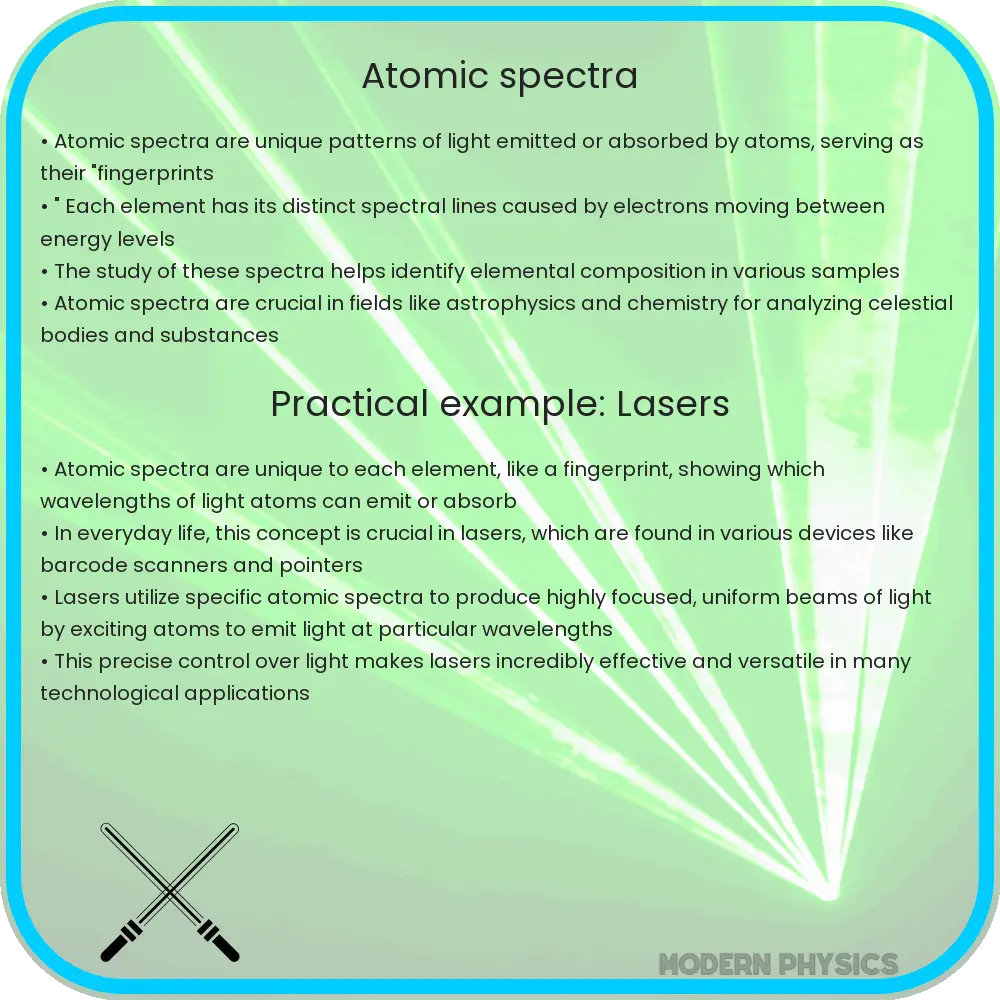Atomic spectra are unique ‘signatures’ of elements, observed as discrete wavelengths of light emitted or absorbed by electrons transitioning between energy levels.

Understanding Atomic Spectra
Atomic spectra are one of the most powerful tools used to study and understand the atomic and molecular structure of elements. The spectral lines, which appear as a series of discrete wavelengths, provide a unique ‘signature’ for each element, which can be used to identify the composition of various substances.
At its core, atomic spectra arise when electrons in an atom absorb or emit energy. This energy is often in the form of light (photons), and the wavelengths of this light form what we observe as spectra. In essence, each element has electrons that move between different energy levels under specific conditions, which results in the emission or absorption of light at specific wavelengths.
Types of Atomic Spectra
- Emission Spectra: This type of spectrum is produced when excited atoms return to a lower energy state, emitting light of certain wavelengths in the process. An everyday example is the colorful neon signs where each gas emits light of specific colors.
- Absorption Spectra: In contrast to emission, absorption spectra are produced when electrons absorb energy and move to higher energy levels. This can often be seen in the analysis of starlight, as elements in the star’s atmosphere absorb certain wavelengths.
Generating and Observing Atomic Spectra
To generate visible atomic spectra in a laboratory setting, several methods can be employed:
- Using a flame to heat a sample of an element, which provides the energy for electrons to jump to higher energy states and then emit specific wavelengths as they return to their ground state.
- Passing electricity through a gaseous sample of an element (as done in gas discharge tubes) to excite the atoms, which then emit light as they return to lower energy levels.
- Shining a continuous spectrum light on a sample which will absorb specific wavelengths revealing an absorption spectrum.
The observation and analysis of these spectra require the use of a spectrometer – an instrument that separates incoming light by its wavelength. By analyzing the wavelengths of light that are either emitted or absorbed, researchers can infer the chemical makeup of the source.
Practical Application: Bohr’s Model of the Hydrogen Atom
Niels Bohr’s model of the hydrogen atom gave profound insight into the structure of atomic spectra. Bohr proposed that an electron in a hydrogen atom could only occupy certain orbits or shells and that light was emitted or absorbed as electrons moved between these orbits. The energy difference between these orbits determines the wavelength of the emitted or absorbed light. The relationship can be expressed by the following equation:
E = – \frac{{13.6 eV}}{n2}
Where E is the energy and n is the principal quantum number of the orbit. When transitioning between two energy levels (from n1 to n2), the wavelength of the emitted or absorbed light (λ) can be found from:
\frac{1}{\lambda} = R \left( \frac{1}{n12} – \frac{1}{n22} \right)
Here, R is the Rydberg constant (approximately 1.097 x 107 m-1). This formula, known as the Rydberg formula, was pivotal in advancing our understanding of atomic structures and spectral lines.
By using principles like the Rydberg formula, scientists have been able to deduce not only the electronic structures of various elements but also use these spectral lines to determine the composition and conditions of distant celestial bodies.
Expanding the Horizon: Spectroscopy in Astronomy
Spectroscopy goes beyond the laboratory and plays a vital role in astronomy. Astronomers rely on the spectral analysis of celestial objects to understand their composition, temperature, density, and motion. This information is crucial for studying stars, planets, and distant galaxies.
For instance, by observing the absorption spectra of a distant star, astronomers can identify the elements present in the star’s atmosphere. The Doppler shift in the spectral lines can also indicate whether an object is moving towards or away from us, providing valuable insights into the dynamics of the universe.
Environmental Monitoring and Industrial Applications
On Earth, spectroscopy equips us to monitor environmental pollution and quality. Specialists use absorption spectroscopy to detect contaminants in water and air, aiding in the enforcement of environmental regulations. Similarly, emission spectroscopy finds extensive use in industrial processes to monitor the purity of products and efficiency of operations.
One practical application can be observed in the metallurgy industry, where this technique ensures the correct composition of metals and alloys, thus guaranteeing the integrity and durability of manufactured products.
Conclusion
Atomic spectra offer a fascinating glimpse into the microscopic world of atoms and molecules. From the fundamental theories proposed by Niels Bohr to the complex applications in modern science and industry, the study of atomic spectra remains integral to our exploration and understanding of both the tiniest particles and the most expansive cosmic entities.
Whether it is deciphering the elemental composition of a distant star or ensuring the safety of our drinking water, the principles of spectroscopy impact areas wide and far-reaching. By continuing to explore and understand these principles, we not only satisfy our curiosity about the nature of matter but also develop better technologies for our future.
Atomic spectra and spectroscopy, in general, exemplify how a deep understanding of basic physics concepts can lead to advancements across various scientific fields, demonstrating the interconnectedness of the universe’s physical laws and the practical life applications they entail.
